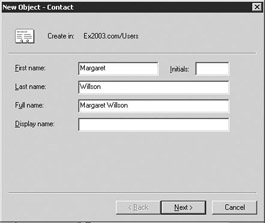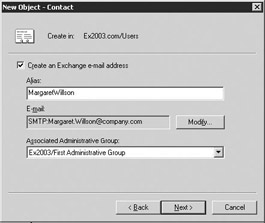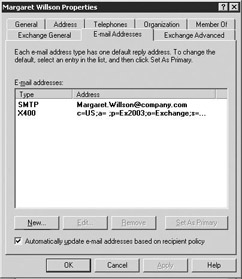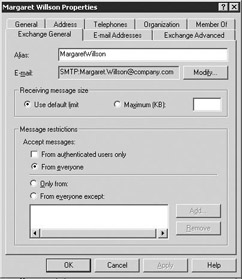7.2 Managing mail-enabled contacts
|
| < Day Day Up > |
|
Mail-enabled contacts are just address list entries for people outside the corporate Exchange messaging organization, such as Internet recipients. These contacts appear in the Exchange address lists, and Exchange users can send mail to these recipients. For example, corporate users may regularly send enough e-mail to an external consultant to warrant adding the consultant's name to the GAL. Rather than each user recording the external user's e-mail address, you can create a mail-enabled contact entry for the person. The contact's name and e-mail address can be included in your Exchange address lists, even though they do not have an Exchange mailbox. In previous versions of Exchange, both mail-enabled users and mail-enabled contacts were known as custom recipients. You can use Active Directory Users and Computers to manage mail-enabled contacts.
7.2.1 Creating a mail-enabled contact
You can use the following procedure to create a mail-enabled contact.
-
Start the Active Directory Users and Computers from the Windows Start menu by selecting All Programs →Microsoft Exchange →Active Directory Users and Computers.
-
Right-click on Users and select New →Contact.
-
Enter the user's given name, initials, and surname into the First name, Initials, and Last name fields (Figure 7.20). Windows will automatically fill in the Full name field by combining the First name, Initials, and Last name fields. You can override this value if necessary.

Figure 7.20: New Mail-enabled Contact - Name dialog box -
In the Display name field, enter the user's display name. The display name for both internal and external contacts should follow the same standards as the display names you use for Exchange users. A commonly used format is the user's last name, followed by a comma, followed by the user's first name, then initials (if needed). If additional information is needed to help distinguish names, you can add extra information, such as the user's department or location, after the user's name (e.g., Smith, John [Atlanta]). For external contacts, it is usually a good practice to include the person's company name as part of the display name (e.g., Smith, John [Company]).
-
Select Next to continue.
-
Select the Create an Exchange e-mail address check box to automatically create an e-mail address that will be included in the Exchange address lists.
-
By default, Exchange creates the mail-enabled contact Alias field by combining the user's first name and last name, without any spaces (Figure 7.21). You can override this value if necessary.

Figure 7.21: New Mail-enabled Contact - Alias dialog box -
To enter the e-mail address, select the Modify button to display a list of the e-mail address types. In the New E-mail Address dialog box, select the type of address and then select OK. In the Address Properties dialog box, enter the information required by the address type you selected. Then select OK.
-
Select Next to display a dialog box summarizing the information you entered.
-
Verify that the information is correct and then select Finish to create the contact. Select Back if you need to correct any information.
The new contact process collects only a minimal amount of information. It is enough to allow the contact to receive e-mail, but it does not include the additional information needed to produce a fully populated GAL entry for the contact. The minimal information also is typically inadequate to effectively create custom address lists on the basis of attributes such as location or department. This additional information can be entered only by modifying the contact's entry once it has been created.
7.2.2 Modifying a mail-enabled contact
You can use the following procedure to modify an existing mail-enabled contact.
-
Start the Active Directory Users and Computers from the Windows Start menu by selecting All Programs →Microsoft Exchange →Active Directory Users and Computers.
-
Expand the Users section.
-
In the details pane, right-click the contact you want to modify, and select Properties.
-
E-mail Addresses tab Select the E-mail Addresses tab. The E-mail Addresses tab is used to maintain alternate e-mail addresses for this mail-enabled contact. You can have multiple e-mail addresses of the same type. For example, you can assign two SMTP addresses to the recipient. If you have multiple addresses for an address type, the primary address appears in boldface type (Figure 7.22).

Figure 7.22: Mail-enabled Contact Properties - E-mail Addresses tab -
You can add new e-mail addresses for the mail-enabled user or contact. To add a new e-mail address, select the New button to display a list of the e-mail address types you can add. The available choices are X.400, Microsoft Mail, SMTP, cc:Mail, Lotus Notes, Novell GroupWise, and custom. If you have installed other third-party products, such as fax connectors, additional e-mail address types may be listed. Select the type of address you want to add, then select OK. The system will display an Address Properties dialog box that is specific for the type of address you are adding. In the Address Properties dialog box, enter the information required by the address type you selected. Select OK to return to the E-Mail Addresses tab.
-
To change an e-mail address for a mail-enabled contact, double-click the address you want to modify to display the Address Properties dialog box. This dialog box is specific for the type of address you are adding. In the Address Properties dialog box, change the e-mail address information, then select OK to return to the E-Mail Addresses tab.
-
When the recipient no longer needs a particular address, you can remove the unnecessary address by selecting the e-mail address and then selecting the Remove button. You can remove any address, except for the primary SMTP address, because all recipients must have at least one SMTP address. To remove the primary SMTP address, you must first designate another SMTP address as the primary one.
-
If you have multiple addresses for an address type, the primary address appears in boldface type. To change the primary address, select the new primary address and select Set as Primary. The new primary address appears in boldface type.
-
A user's e-mail addresses are automatically generated according to the recipient policies. This keeps you from having to manually enter e-mail addresses for each of your users. However, you may have a small number of users who are exceptions to the address generation rules defined by the recipient policies. For these exceptions, you will need to manually enter their e-mail addresses and clear the Automatically update e-mail addresses based on recipient policy check box to prevent the recipient policies from updating the user's addresses.
-
Exchange General tab Select the Exchange General tab to display information about the user's alias, e-mail address, or delivery restrictions (Figure 7.23).

Figure 7.23: Mail-enabled Contact Properties - Exchange General tab -
To change the contact's alias, enter a new value into the Alias field.
-
To change the e-mail address, select the Modify button to display an E-Mail Address dialog box. You can either change the current address to another address of the same type (e.g., switch from one SMTP address to another SMTP address) or create the new address based on a different type (e.g., switch from an SMTP address to a cc:Mail address).
-
Select Modify existing e-mail address to display the Address Properties dialog box. Enter the new address in the E-mail address field and select OK to return to the Exchange General tab.
-
Select Create new e-mail address to display a list of the e-mail address types. In the New E-mail Address dialog box, select the type of address, then select OK. In the Address Properties dialog box, enter the information required by the address type you selected. Then select OK.
-
-
You can use the Receiving message size options to specify the maximum acceptable message size that this recipient can receive. Mail-enabled contacts have an e-mail address so they can receive e-mail, but because they do not have an Exchange mailbox, the message will not be stored on your Exchange server. Select Maximum (KB) and enter a value into the associated field to specify a limit for this user. Select Use default limit to use the default maximum size as defined in the Message Delivery Properties in the Global Settings section of Exchange System Manager console.
-
You can use the Message restrictions options to control the users who can send e-mail messages to this recipient.
Select the From authenticated users only check box to accept messages only from authenticated users.
Select From everyone if you do not want to place restrictions on who can send e-mail to this user. By default, mail-enabled contacts can accept messages from anyone.
Alternatively, you can set restrictions so that only e-mail from a specific set of users can be sent to this user. To list specific users who can send e-mail to this user, select Only from. Then select the Add button to display the Select Recipient dialog box. In the Select Recipient dialog box, select the users who will be allowed to send e-mail to this recipient. When you have identified these users, select OK to return to the Exchange General tab.
You also can elect to allow messages to be accepted from everyone except a specific set of users. To list specific users who will not be allowed to send e-mail to this user, select From everyone except. Then select the Add button to display the Select Recipient dialog box. In the Select Recipient dialog box, select those users who will not be allowed to send e-mail to this recipient. When you have identified these users, select OK to return to the Exchange General tab.
-
Select the Exchange Advanced tab (Figure 7.24).

Figure 7.24: Mail-enabled Contact Properties - Exchange Advanced tab -
Exchange Advanced tab Exchange sends the simple display name to other e-mail systems that cannot understand any non-ANSI characters you may have used in the user's normal display name. To set a simple display name, enter the name into the Simple display name field. The name should include only ANSI characters.
-
By default, all recipients are listed in Exchange address lists. Select the Hide from Exchange address lists check box to prevent this mail-enabled contact from appearing in address lists. This discourages-but does not prevent-users from sending mail to the hidden user. Mail can still be sent to the recipient if the sender types the address into the To field rather than selecting the name from an address list.
-
Select the Use MAPI rich text format if this contact can receive e-mail in MAPI Rich Text format. This format allows messages to have attachments and character attributes, such as bold, italics, and color.
-
To enter company-specific information, select the Custom Attributes button to display the Exchange Custom Attributes dialog box. In the Exchange Custom Attributes dialog box, select the attribute ( extension-Attribute1 through extensionAttribute15) you want to change, then select Edit. Enter a value for the custom attribute and select OK to return to the Exchange Custom Attributes dialog box. Select OK to return to the Exchange Advanced tab of the Properties dialog box.
-
You can use the ILS to provide information about your users to the managers of websites that your users visit. Sharing this information facilitates communication between website managers and users. If you want to share this information, select the ILS Settings button to display the Exchange ILS dialog box. In the ILS Server field, enter the name of the server to which this user is connected. In the ILS Account field, enter the user's account name. Select OK to return to the Exchange Advanced tab of the Properties dialog box.
|
| < Day Day Up > |
|
EAN: 2147483647
Pages: 128